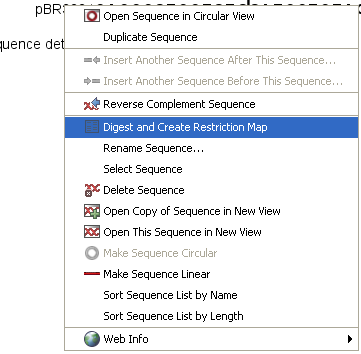Manipulate the whole sequence
Right-click the sequence label to the left to see the menu shown in figure 32.23.

Figure 32.23: Right click on the sequence in the cloning view.
- Duplicate sequence.
Adds a duplicate of the selected sequence to the sequence list accessible from the drop down menu on top of the Cloning view.
- Insert sequence after this sequence (
 ).
The sequence to be inserted can be selected from the sequence list via the drop down menu on top of the Cloning view. The inserted sequence remains on the list of sequences.
If the two sequences do not have blunt ends, the ends' overhangs have to match each other.
).
The sequence to be inserted can be selected from the sequence list via the drop down menu on top of the Cloning view. The inserted sequence remains on the list of sequences.
If the two sequences do not have blunt ends, the ends' overhangs have to match each other.
- Insert sequence before this sequence (
 ).
The sequence to be inserted can be selected from the sequence list via the drop down menu on top of the Cloning view. The inserted sequence remains on the list of sequences. If the two sequences do not have blunt ends, the ends' overhangs have to match each other.
).
The sequence to be inserted can be selected from the sequence list via the drop down menu on top of the Cloning view. The inserted sequence remains on the list of sequences. If the two sequences do not have blunt ends, the ends' overhangs have to match each other.
- Reverse sequence.
Reverses the sequence and replaces the original sequence in the list. This is sometimes useful when working with single stranded sequences. Note that this is not the same as creating the reverse complement of a sequence.
- Reverse complement sequence (
 ).
Creates the reverse complement of a sequence and replaces the original sequence in the list. This is useful if the vector and the insert sequences are not oriented the same way.
).
Creates the reverse complement of a sequence and replaces the original sequence in the list. This is useful if the vector and the insert sequences are not oriented the same way.
- Digest and Create Restriction Map (
 ).
See Separate fragments on gel
).
See Separate fragments on gel
- Rename sequence.
Renames the sequence.
- Select sequence.
Selects the entire sequence.
- Delete sequence (
 ).
Deletes the given sequence from the cloning editor.
).
Deletes the given sequence from the cloning editor.
- Open sequence (
 ).
Opens the selected sequence in a normal sequence view.
).
Opens the selected sequence in a normal sequence view.
- Make sequence circular (
 ).
Converts a sequence from a linear to a circular form.
If the sequence have matching overhangs at the ends, they will be merged together.
If the sequence have incompatible overhangs, a dialog is displayed, and the sequence cannot be made circular.
The circular form is represented by
).
Converts a sequence from a linear to a circular form.
If the sequence have matching overhangs at the ends, they will be merged together.
If the sequence have incompatible overhangs, a dialog is displayed, and the sequence cannot be made circular.
The circular form is represented by  and
and  at the ends of the sequence.
at the ends of the sequence.
- Make sequence linear (
 ).
Converts a sequence from a circular to a linear form, removing the
).
Converts a sequence from a circular to a linear form, removing the  and
and  at the ends.
at the ends.
